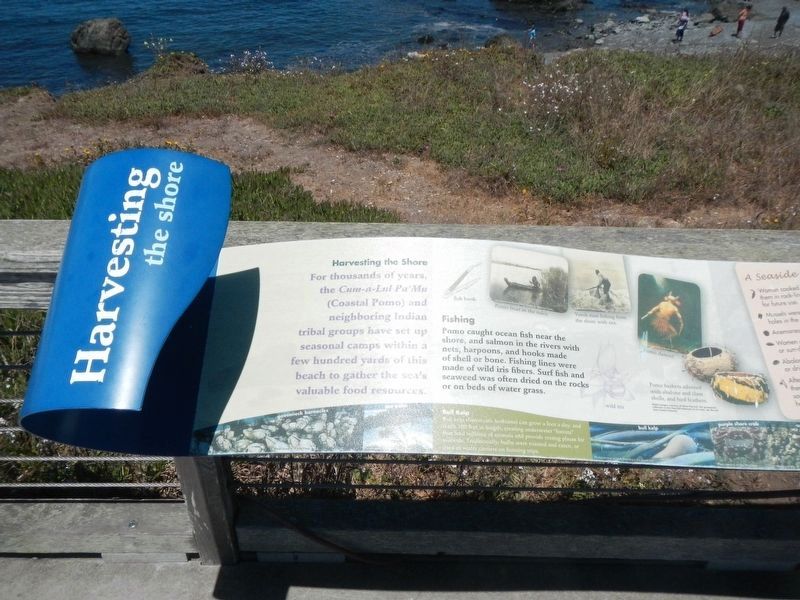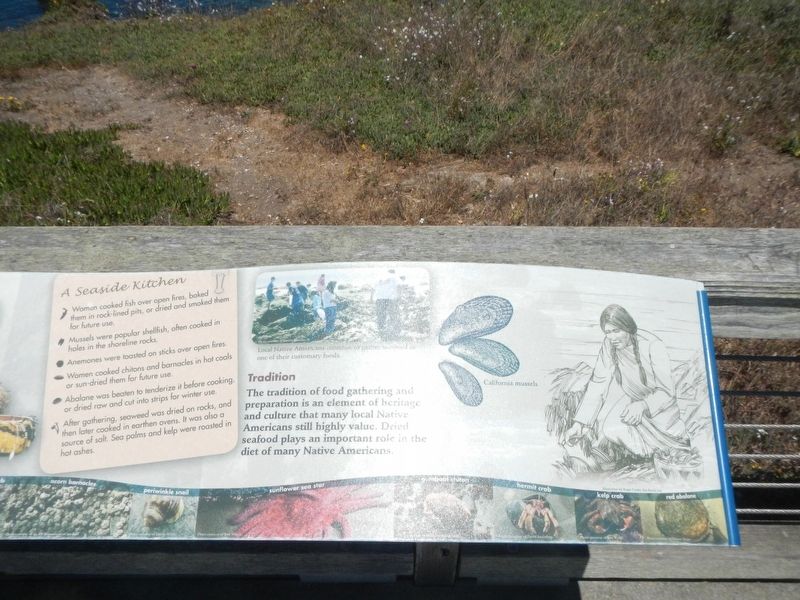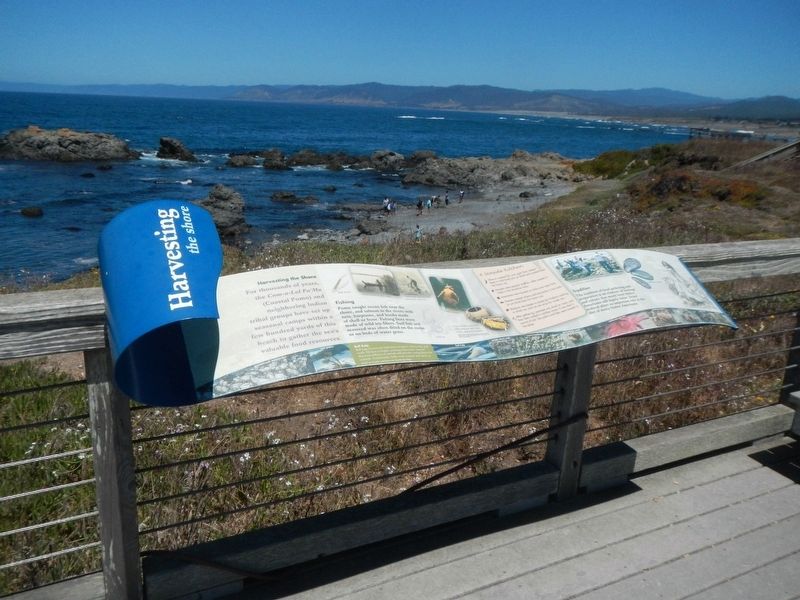Near Cleone in Mendocino County, California — The American West (Pacific Coastal)
Harvesting the Shore

Photographed By Barry Swackhamer, July 22, 2016
1. Harvesting the Shore Marker, left section
Captions: (top row, left to right) fish hooks; Pomo boat in the tules; Yurok man fishing from the shore with net; Pomo dancer; Pomo baskets adorned with abalone and clam shells and bird feathers.; Local Native Americans continued to gather seaweed, one of their customary foods.; California mussels; (bottom row, left to right) gooseneck barnacles; sea palm; bull kelp (Nereocystis luetkeana) can grow a foot a day and reach 100 feet in length creating underwater "forests" that feed millions of animals and provide resting places for seabirds. Traditionally bulbs were roasted and eaten, or used as water carriers on hunting trips.; purple shore crab, acorn barnacles; periwinkle snail; sunflower sea star,; gumboot chiton; hermit crab; kelp crab; red abalone.
Fishing
Pomo caught ocean fish near the shore, and salmon in the rivers with nets. harpoons, and hooks made of shell and bone. Fishing lines were made of wild iris fibers. Surf fish and seaweed was often dried on the rocks or on beds of water grass.
A Seaside Kitchen
Women cooked fish over open fires, baked them in rock-lined pits, or dried and smoked then for future use.
Mussels were popular shellfish, often cooked in holes of the shoreline rock.
Anemones were toasted on sticks over open fires.
Women cooked chitons and barnacles in hot coals or sun-dried them for future use.
Abalone was beaten to tenderize it before cooking, or dried raw and cut into strips for winter use.
After gathering, seaweed was dried on rocks, and then later cooked in earthen ovens. It was also a source of salt. Sea palms and kelp were roasted in hot ashes.
Tradition
The tradition of food gathering and preparation is an element of heritage and culture that many local Native Americans still highly value. Dried seafood plays an important role in the diet of many Native Americans.
Erected by California State Parks.
Topics. This historical marker is listed in these topic lists: Anthropology & Archaeology • Native Americans.
Location. 39° 29.376′ N, 123° 48.148′ W. Marker is near Cleone, California, in Mendocino County. Marker can be reached from Mill Creek Drive near California Route 1. Touch for map. Marker is in this post office area: Fort Bragg CA 95437, United States of America. Touch for directions.
Other nearby markers. At least 8 other markers are within 3 miles of this marker, measured as the crow flies. Timber Years (about 300 feet away, measured in a direct line); Surrounded By Trees (approx. 2.6 miles away); Our Past Through Our Trash (approx. 2.7 miles away); The Weller House (approx. 3 miles away); First Baptist Church Bell (approx. 3 miles away); Dynamite Shack (approx. 3 miles away); Fort Building (approx. 3 miles away); Major William F. Mullen Freedom Tree (approx. 3.1 miles away).
More about this marker. This marker is located on the Laguna Point Trail in MacKerricher State Park.

Photographed By Barry Swackhamer, July 22, 2016
2. Harvesting the Shore Marker, right section
Captions: (top row, left to right) fish hooks; Pomo boat in the tules; Yurok man fishing from the shore with net; Pomo dancer; Pomo baskets adorned with abalone and clam shells and bird feathers.; Local Native Americans continued to gather seaweed, one of their customary foods.; California mussels; (bottom row, left to right) gooseneck barnacles; sea palm; bull kelp (Nereocystis luetkeana) can grow a foot a day and reach 100 feet in length creating underwater "forests" that feed millions of animals and provide resting places for seabirds. Traditionally bulbs were roasted and eaten, or used as water carriers on hunting trips.; purple shore crab, acorn barnacles; periwinkle snail; sunflower sea star,; gumboot chiton; hermit crab; kelp crab; red abalone.
Credits. This page was last revised on August 10, 2016. It was originally submitted on August 10, 2016, by Barry Swackhamer of Brentwood, California. This page has been viewed 362 times since then and 27 times this year. Photos: 1, 2, 3. submitted on August 10, 2016, by Barry Swackhamer of Brentwood, California.
